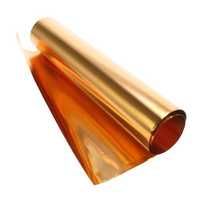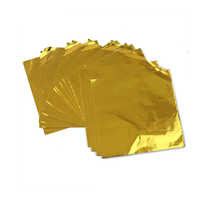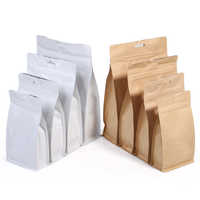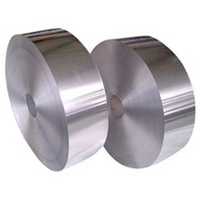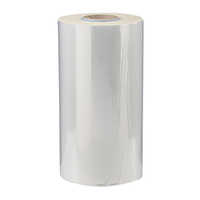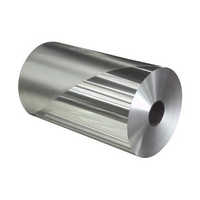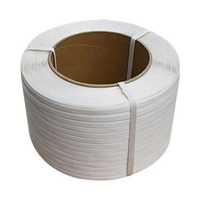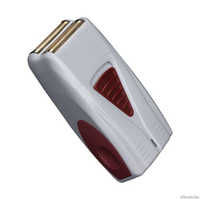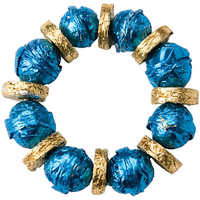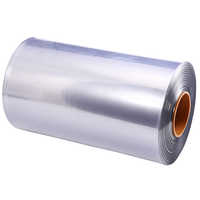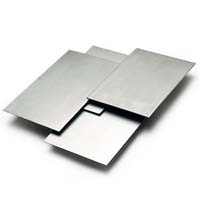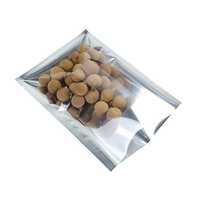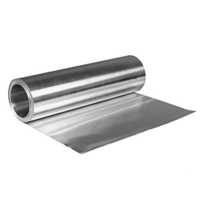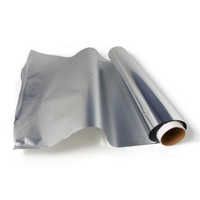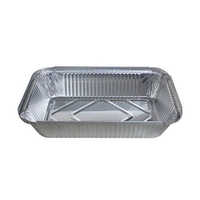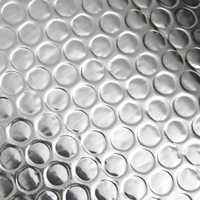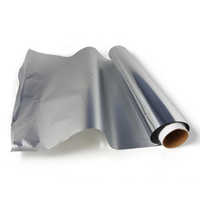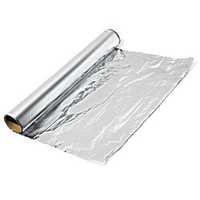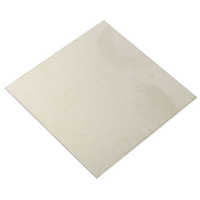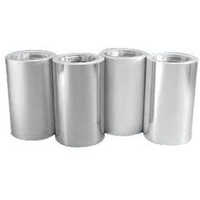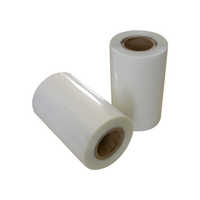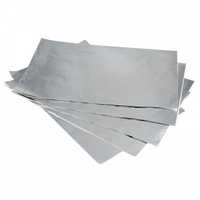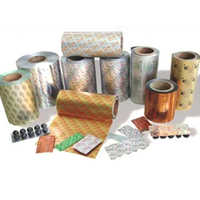Packaging Foil
(1896 products)
Explore More Categories
Laminated Foil Pouches
Price: 5000 INR (Approx.)/Piece
MOQ - 1000 Piece/Pieces
21 Years
Business Type: Manufacturer | Supplier
QED KARES PACKERS PVT. LTD.
Aluminum Packaging Lid Foils
Material - Laminated Material
Size - Customized
Transparency - Opaque
4 Years
Business Type: Manufacturer | Supplier
LABH PROJECTS PVT. LTD.
Verified Exporter
( Accepts only Foreign Inquiry)
Aluminum Foil
Price: 330 INR (Approx.)/Roll
MOQ - 5 Roll/Rolls
9 Years
Business Type: Manufacturer | Exporter
DISPOSABLE POINT
Indian Inquiries Only
Black Flux Cored Brazing Wire
Price Trend: 30.00 - 50.00 INR (Approx.)/Kilograms
MOQ - 5 Kilograms/Kilograms
Product Type - Brazing Wire
Usage - Industrial
Color - Black
3 Years
Business Type: Manufacturer | Exporter
SHANGHAI EHAN-AM CO., LTD.
Papyrus Food Grade 1 KGs Advanced Aluminum Foil
Price: 495 INR (Approx.)/Box
MOQ - 10 cartons Box/Boxes
5 Years
Business Type: Manufacturer | Distributor
M/S MATRIX TISSUES
Alu Alu Foil
Price: 270 INR (Approx.)/Kilograms
MOQ - 50 Kilograms/Kilograms
5 Years
Business Type: Manufacturer
M V H PRINTERS
Reflective Insulation
Business Type: Manufacturer | Distributor
TIRI INNOVATIONS PRIVATE LIMITED
Aluminum Foil Pouch
Price Trend: 180.00 - 245.00 INR (Approx.)/Kilograms
MOQ - 8500 Kilograms/Kilograms
7 Years
Business Type: Manufacturer
RAGHUVANSHI INDUSTRIES
High Grade Aluminium Foil Roll
Price Trend: 75-1000 INR (Approx.)/Roll
MOQ - 100kg Roll/Rolls
4 Years
Response Rate: 82.86%
Business Type: Manufacturer | Distributor
SHREE PRAGYA TECHPACK PRIVATE LIMITED
Sliver Aluminium Foil Bag
Price: 5 INR (Approx.)/Piece
MOQ - 25 Piece/Pieces
Thickness - 0.5-1.5 Millimeter (mm)
Shape - Rectangle
Product Type - Aluminum Foils
3 Years
Business Type: Manufacturer
GUJARAT MARKETING
Indian Inquiries Only
Aluminium Barrier Foil
Price Trend: 360.00 - 500.00 INR (Approx.)/Square Meter
MOQ - 10 Square Meter/Square Meters
4 Years
Response Rate: 93.33%
Business Type: Manufacturer
BRANOPAC INDIA PVT. LIMITED
Available All Colors Eco Friendly Durable Silver Aluminium Foil Rolls
Price: 350 INR (Approx.)/Kilograms
MOQ - 350 Kilograms/Kilograms
2 Years
Business Type: Manufacturer | Supplier
M/SAyush Flexipack Pvt. Ltd.
Stretch Wrapping Roll
Price: 120 INR (Approx.)/Kilograms
MOQ - 100 Kilograms/Kilograms
5 Years
Business Type: Manufacturer
ANMOL ADHESIVES
Indian Inquiries Only
3 Layer Dull Aluminium Foil Laminates Roll
Price: 150.00 INR (Approx.)/Kilograms
MOQ - 9 Kilograms/Kilograms
6 Years
Business Type: Trading Company
RITUL INTERNATIONAL
Indian Inquiries Only
Blister Paper Aluminium Foil
Price Trend: 160.00 - 260.00 INR (Approx.)/Kilograms
MOQ - 1000 Kilograms/Kilograms
10 Years
Business Type: Manufacturer | Distributor
G T Pack Industries
Aluminum Blister Foil Easy To Use
Price: 400 INR (Approx.)/Kilograms
MOQ - 1000 Kilograms/Kilograms
Material - Other
Processing - Multiple Extrusion
Transparency - Opaque
9 Years
Business Type: Manufacturer | Supplier
RACHANA PLASTICS
8x15 CM Custom Printed Flexible Heat Sealable Aluminum Foil Packaging Pouch
2 Years
Business Type: Manufacturer | Exporter
ACCURETTA COMPOSITES
Nickel Foil For Spot And Laser Welding Thickness 0.05mm to 0.50mm Purity > 99.6%
Price: 3000 INR (Approx.)/Kilograms
MOQ - 10 Kilograms/Kilograms
Color - Silver
Product Type - Nickel Foil
Material - Nickel
6 Years
Business Type: Manufacturer | Distributor
RAMANI STEEL HOUSE
72 Meter Aluminium Foil
Price: 360.00 INR (Approx.)/Piece
MOQ - 10 Piece/Pieces
5 Years
Business Type: Distributor
ATUL TRADING COMPANY
Indian Inquiries Only
Silver Chrome Vinyl Roll
Price Trend: 50.00 - 250.00 INR (Approx.)/Roll
MOQ - 30 Roll/Rolls
3 Years
Business Type: Distributor | Trading Company
RAJ TRADERS
Indian Inquiries Only
Packaging Foil Manufacturers | Suppliers in India
| Company Name | Location | Member Since |
|---|---|---|
| Qed Kares Packers Pvt. Ltd. | Ghaziabad, India | 21 Years |
| Hitesh Steel | Mumbai, India | 18 Years |
| Surya Products Ltd. | Delhi, India | 15 Years |
| Aditya Packaging & Consulting Service Pvt. Ltd. | Pune, India | 10 Years |
| G T Pack Industries | Greater Noida, India | 10 Years |
| Disposable Point | Gurugram, India | 9 Years |
| Rachana Plastics | Vasai, India | 9 Years |
| Harsh Corporation | Mumbai, India | 8 Years |
| Raghuvanshi Industries | Thane, India | 7 Years |
| Kbk Polymers Pvt. Ltd. | New Delhi, India | 6 Years |
Packaging Films: Different Types & Applications
One sector that exemplifies this trend is the packaging market. As a result of flexible packaging's launch and subsequent success, the market is expanding rapidly. Plastic films are superior to other types of food packaging in terms of safety. Reduced risk of contamination and theft makes this material highly desirable. Food products have a longer shelf life. The material is used for both visual appeal and product differentiation in the food industry.
Plasticized polyvinylidenechloride, or PVCD, is used to make packaging films with regulated CO2 and O2 transmission. Putting gassing cheese in a package like this film is a great idea. The formulations of the films are created in such a way that the permeability to CO2 increases while the permeability to O2 probably remains the same. Films used for packaging often undergo orienting or thermoforming. Thermoforming involves stretching film into a mold or hollow to create a customized container. Films are stretched in this way by biaxially and planarly orienting them below the melting point of one or more layers.
The film is stretched under comparable conditions in orientation procedures including the tenter frame, double bubble, and machine direction orientation operations to improve physical characteristics or impart shrink. Performance-affecting processes and material factors are discussed in this chapter for both procedures.
Applications
- Water, drink, and milk storage bottles
- Tubs of margarine
- Liners for cereal boxes
- Shopping, trash, and produce bags
- Food containers with squeeze caps
- Bread bags and ice cream containers
- Contourable covers
- Bottles for salad dressing
- The Margarine Container
- Milk jugs for yogurt
- bottles made of plastic used for holding carbonated beverages
- In containers such as bottles, jars, and tubs
- packaging for packaged foods and snacks
Different Types of Packaging Films
1. Laminates
You see laminated Packaging Films for food packaging all the time; it's common for flavored drinks, food products like sauces, and preserved foods and powders to come in laminated packaging. Typically, aluminum or metalized films are supported by a polymer film or a paper film in the multilayer structure of these films. The materials used in their construction also work to effectively block the transmission of odors and aromas.
2. BOPA- Biaxially Oriented Polyamide
Similar to BOPET, BOPA has remarkable tensile strength, durability, scent barrier, and puncture resistance. However, the extreme degree of transparency it possesses is its most prized quality. It acts as a protective shield against air and some chemicals. Items such as frozen and cooked foods, vegetables, aquatic equipment, medical devices, electronic products, etc., all benefit from being packaged in these films. It is also appropriate for use with agricultural and even some medicinal supplies.
3. BOPET- Biaxially Oriented Polyethylene Terephthalate
BOPET films, which were initially produced in the midst of the 1950s, are often white or translucent. The material is polyethylene terephthalate that has been stretched (PET). Their popularity stems from the fact that they are see-through, reflective, chemically stable, dimensionally consistent, soundproof, odor proof, and gas-proof in addition to being insulating. It's also commonly utilized as a lamination surface film.
Laminating food products with BOPET foil helps prevent oxidation, which helps preserve the original flavors and fragrances of the food and extends its shelf life. Convenience food pouches and coffee foil packages are two examples. Newfangled Pop-Tarts in silver BOPET packaging are a humorous case in point.
4. BOPE- Bi-axially Oriented Polyethylene
If you need to ship items that are very rigid in their packing, BOPE is your best bet. These films are great because they are transparent, have a high gloss, and are puncture-resistant, heat-seal strong, durable, and moisture-resistant. These films can be made for a reasonable price. These days, BOPE films are cutting-edge alternatives frequently used to package foodstuffs, medicines, and even seasonings like salt and pepper. Because of their recyclable nature, these films enable businesses to fulfill their sustainability promises to customers. Despite their many benefits, these flicks are surprisingly low-cost.
5. BOPP- Bi-axially Oriented Polypropylene Polymer
These films provide unrivaled longevity, moisture resistance, and clarity, making them the superior option for commercial packaging. FOIL is commonly used to supplement BOPP. The functionality is much enhanced as a result. Clear wrapping and various snack food containers are two examples of where BOPP films are employed nowadays. Packages for pesticides and toiletries are two additional frequent recipients. Due to their high degree of recyclable nature, these films aid businesses in keeping their sustainability promises to customers.
6. LDPE- Low-Density Polythene
A packaging film since its inception in 1933, LDPE is a polyethylene that is both lightweight and extremely malleable. Essentially, it is a thermoplastic derived from ethylene monomer. These films excel in areas where flexibility, durability, corrosion resistance, and chemical and impact resistance are required, such as at low temperatures. Additionally, they are conveniently made by a high-pressure technique via free radical polymerization. Due to their ability to assure conformity with food safety regulations and their recyclable nature, they are the most sought-after in the food packaging business. Lids for canned goods, supermarket bags, and plastic wraps and films are all products of LDPE's production. It is also used for blow molding, injection molding, and extrusion processing.
7. LLDPE- Linear Low-Density Polyethylene
Because it is the most malleable, LLDPE plastic sheeting film is at the top of the list. It is essentially a refined variant of LDPE, and it has the remarkable potential to absorb impact without puncturing or ripping. In addition to their adaptability, these films are notable for their longevity and chemical resistance. Plastic bags, wraps, pouches, toys, covers, lids, pipes, buckets, containers, and the like are typical examples. They are also commonly utilized as pond liners, carpet backing, cable jackets, geomembranes, and most importantly, flexible tubing.
Uses of Packaging Films
- Rice and other types of edible items are frequently packaged with LDPE films these days. The first method is utilized quite commonly when it comes to the packaging of electronic components.
- Tablets, facial masks, IC boards, and other items can be packaged in laminated aluminum foil bags. Other uses include packaging for facial masks.
- Bags made of laminated material that have one-way valves. Powders of various sorts, food for pets, and other applications are common usage.
- The likes of seasonings, sauces, meat products, and other types of gastronomic preparations can be packaged in retort pouches.
- Bags and pouches made of standard laminated material are utilized in the packaging of products in the fields of food, pharmaceuticals, and cosmetics.
- Stand-up zipper pouches are commonly used for packaging a variety of items, including milk powder, confectionery goods, and food for pets.
- Bags and pouches that are vacuum-packed find use in a variety of food categories, including seafood, frozen prepared foods, and more.
Uses in Non-Food Products:
- Cosmetics
- Pharmaceuticals
- Insulation
Uses for Food products:
- Freezer to microwave
- Boil in bag pouches
- Ready-to-eat food such as beverages, ice creams, and snacks
The production of flexible packaging is far more cost-effective. Laminating several layers of films together creates a flexible packaging material. Production costs for flexible packaging films are significantly cheaper than those of conventional glass and plastic jars. Using high-quality films, you may frequently eliminate the requirement for and associated cost of additional packaging materials like corrugated trays. Additionally, the implementation cost of flexible packaging film is far lower than that of plastic or glass containers, both in terms of raw materials and production expenses.
Due to its low weight, flexible packaging reduces transportation costs both locally and globally. Adding extra layers to your flexible packaging design may seem counterintuitive at first, but it can really assist improve production costs and functionality by giving you more exact control over the layers and fewer constraints. In this way, sophisticated engineering is avoided to a large extent.
FAQs: Packaging Films
Q. What are the classifications of films in packaging?
Ans. Here are the classifications:
- Degradable Packing Film
- Nano-laminated packaging Film
- Antibacterial food packaging film
- Edible Packaging Film
- General Packaging film
Q. What are food packaging films?
Ans. Packaging film is a thin plastic sheet used to store, transport, promote, and sell food products. It prevents the food from becoming inedible, turning brown, losing its flavor, or losing its scent.
Q. Where can I buy packaging films in bulk?
Ans. You can buy bulk quantity packaging films from Trade India because it has high-quality packing film options at affordable rates.
Q. What are the prices of different packaging films?
Ans. The different packaging films are available in different price ranges however the cost of packaging film is between 180- 700 INR.
Related Categories
Adhesive Tapes
Aerosols
Agricultural Films
Aluminium & Foils
BOPP Films
Biodegradable Products
Bottle Caps & Plastic Lids
Bottles
Cork & Cork Products
Corrugated Boxes
Craft Paper
Disposable Products
Drums & Barrels
Foam,Rexine & PU Products
Food Packaging Materials
Holograms & Holographic Films
Household Paper
Industrial & Speciality Paper
Industrial Tape
Labels, Stickers & Tags
Lamination Material
Metal Containers & Cans
Napkins
Nets
Non Woven Bags
PP & HDPE Sacks
Packaging & Printing Projects
Packaging Bags
Packaging Boxes
Packaging Clips
Packaging Films
Packaging Foil
Packaging Papers
Packaging Product Stocks
Packaging Products Agents
Packaging Tubes
Packing & Sealing Tapes
Pallets & Crates
Paper & Paper Made Products
Paper Bags
Paper Cone
Paper Cups, Plates & Food Trays
Paper Rolls
Photographic Paper
Plastic Bags
Plastic Boxes
Plastic Containers
Plastic Packaging Materials
Polyester Film
Printing & Writing Paper
Protective Packaging Materials
Sanitary Paper
Straps
Thermal Paper
Thermocol
Tin Containers
Warning Tapes
Woven Bags
